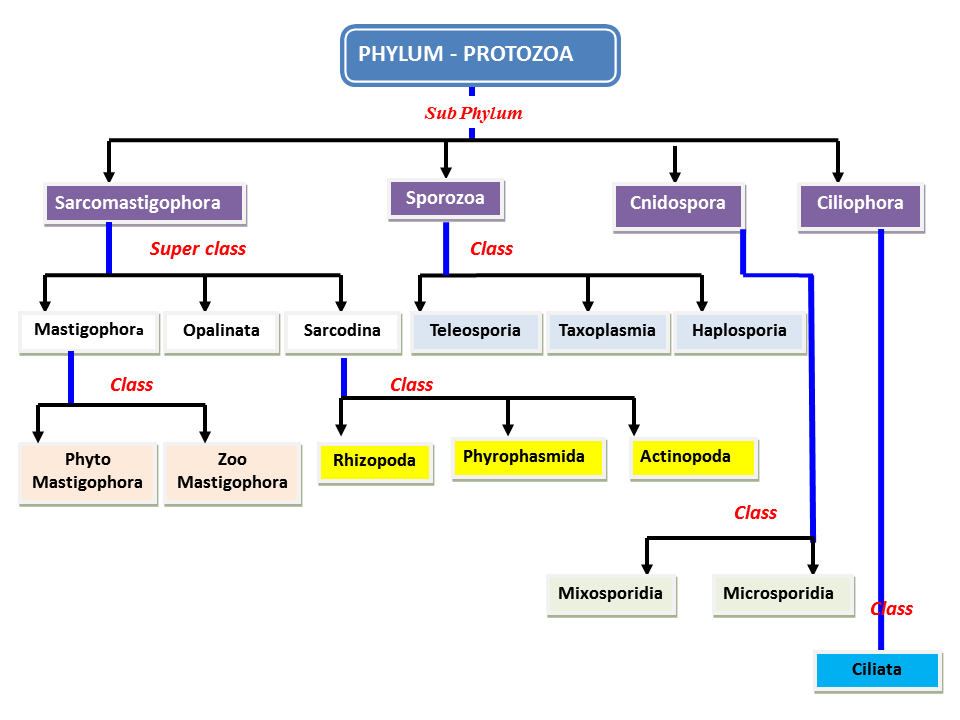
Myonemes are the fine contractile structures in the pellicle and best developed in class___
A) Sarcodina
B) Ciliata
C) Sporozoa
D) All of the above
Answer
583.8k+ views
Hint: Pellicle provides protection to the cell membrane in many types of protozoa. It is like a blanket of protein for extra security to the unicellular organisms of the kingdom Protista under the class Protozoa.
Complete Answer:
What exactly is the pellicle? A pellicle is a very thin layer of protein that protects cell membranes in many types of protozoa, which are free-living or parasitic single-celled eukaryotes that feed on organic matter such as other microorganisms or organic tissues and debris.
The members of protozoa like Plasmodium, Paramecium, Leishmania, are heterotrophic. They either depend on the decomposing of the organic matter to obtain the nutrients or depend on the host cells, in which they cause the disease. The pellicle serves as an additional advantage to these single-celled organisms to thrive and function.
The pellicle, which is directly below the cell membrane and surrounds the cytoplasm, allows organisms like paramecia and ciliates to hold their shapes. The fine layers of translucent membranes also facilitate movement because it is flexible owing to its proteinaceous makeup. The contractile myonemes help in movement by contracting and relaxing.
Myonemes, as evident by their function that we have just discussed, as such protein filaments that can contract when exposed to the calcium ions.
The options provided to us are the classes of Protozoa (as shown below), therefore, all of these will have the myonemes present in the pellicle.

Therefore, the correct answer is option D.
Note: Most of the protozoans are either parasitic or saprophytic, therefore, the pellicle also plays an important role in protection.
Complete Answer:
What exactly is the pellicle? A pellicle is a very thin layer of protein that protects cell membranes in many types of protozoa, which are free-living or parasitic single-celled eukaryotes that feed on organic matter such as other microorganisms or organic tissues and debris.
The members of protozoa like Plasmodium, Paramecium, Leishmania, are heterotrophic. They either depend on the decomposing of the organic matter to obtain the nutrients or depend on the host cells, in which they cause the disease. The pellicle serves as an additional advantage to these single-celled organisms to thrive and function.
The pellicle, which is directly below the cell membrane and surrounds the cytoplasm, allows organisms like paramecia and ciliates to hold their shapes. The fine layers of translucent membranes also facilitate movement because it is flexible owing to its proteinaceous makeup. The contractile myonemes help in movement by contracting and relaxing.
Myonemes, as evident by their function that we have just discussed, as such protein filaments that can contract when exposed to the calcium ions.
The options provided to us are the classes of Protozoa (as shown below), therefore, all of these will have the myonemes present in the pellicle.

Therefore, the correct answer is option D.
Note: Most of the protozoans are either parasitic or saprophytic, therefore, the pellicle also plays an important role in protection.
Recently Updated Pages
A man running at a speed 5 ms is viewed in the side class 12 physics CBSE

State and explain Hardy Weinbergs Principle class 12 biology CBSE

Which of the following statements is wrong a Amnion class 12 biology CBSE

Two Planoconcave lenses 1 and 2 of glass of refractive class 12 physics CBSE

The compound 2 methyl 2 butene on reaction with NaIO4 class 12 chemistry CBSE

Bacterial cell wall is made up of A Cellulose B Hemicellulose class 12 biology CBSE

Trending doubts
What is BLO What is the full form of BLO class 8 social science CBSE

Citizens of India can vote at the age of A 18 years class 8 social science CBSE

Name the states through which the Tropic of Cancer class 8 social science CBSE

Full form of STD, ISD and PCO

Right to vote is a AFundamental Right BFundamental class 8 social science CBSE

Summary of the poem Where the Mind is Without Fear class 8 english CBSE




